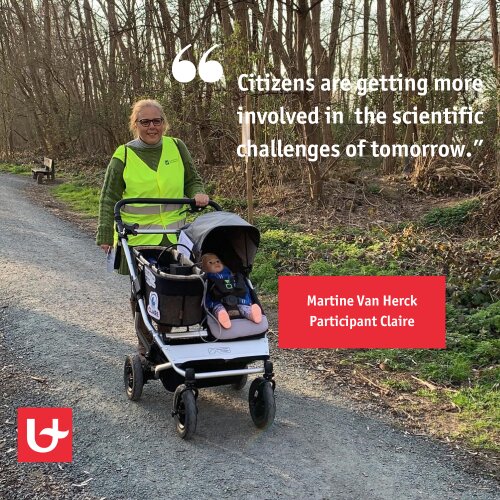
The citizen science project CLAIRE at the University of Antwerp generated a lot of enthusiasm among volunteers. You could go out as a citizen using a buggy with a doll (Claire or Gilbair) and a lot of measuring equipment. In this way, the dolls measured the air quality along predetermined routes. Martine Van Herck and her husband also went out with Claire and later brother Gilbair. In this way they contributed to science.
Healthy interest in science
“I got to know the citizen science project CLAIRE through a magazine or a newsletter. The walks were also close to my home, which immediately attracted me. From my scientific background, I have a healthy interest in air quality and citizen science projects. If you had to call in professionals who immediately analyze measurements during the walk, this would be much more expensive. Now citizens are involved in a socially relevant theme, often together with their children, and you make them enthusiastic about tomorrow's scientific challenges.”
Expansion requires financial support
“At first you could only go out with doll Claire, but later Gilbair also joined. There was of course a financial cost attached to this, so CLAIRE called for a financial contribution. Since I support a good cause every month and CLAIRE is a project that me and my husband have participated in three times, it was a foregone conclusion for me to donate to this.”
“I think it's great in citizen science projects that as a citizen you have the opportunity to support financially and/or participate physically. Of course it is not possible for everyone to make a financial contribution, but in this way you do get the chance to contribute to society. I also like to donate to such projects because it gives you a tax advantage. This way I know that my money is going to a good destination.”
Impact of CLAIRE
“I have always been naturally interested in the aspect of air quality. I myself grew up in a family where both parents smoked and of which I myself have experienced the disadvantages. That is why I think it is important to map “invisible sky”. This can provide many new insights for cities, such as the importance of green belts or more greenery along roads.”
Going out with a buggy
“The walks and everything that came with them were always very professionally organized. It was also great that both dolls had two different walks so that variation was possible if you went out several times with the buggy. We were also given flyers during the walk to hand out to curious passers-by. It is of course a funny sight to see adults walking with a buggy and doll. In this way we were able to inform and enthuse people.”
“During the walk you could occasionally see observations on the measuring equipment. Just think of the fine dust when you crossed the Antwerp Ring. Even when the wind direction changed, you could observe large differences. What I also found very interesting about CLAIRE was that the walks took place at different times during the day and in different weather conditions. This undoubtedly created a lot of variation in the data for later analysis. I am very curious about the results of CLAIRE and what information cities can extract from this to possibly include in their policy.”